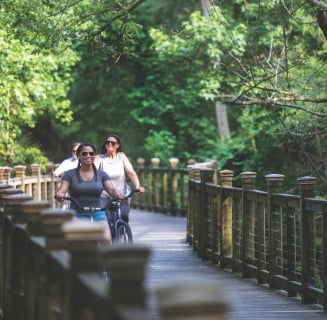
Exploring the audubon newhall preserve
“We came here six years ago,” began Ula Li, “We liked it so much, we had to come back. It’s just as beautiful as we remembered it.” Li and her husband are sitting on a bench overlooking the Audubon Newhall Preserve pond. They are admiring a sunning alligator. “Plus, in Delaware we don’t have alligators.”
EXPLORING THE AUDUBON NEWHALL PRESERVE
“We came here six years ago,” began Ula Li, “We liked it so much, we had to come back. It’s just as beautiful as we remembered it.” Li and her husband are sitting on a bench overlooking the Audubon Newhall Preserve pond. They are admiring a sunning alligator. “Plus, in Delaware we don’t have alligators.”
Jeff Greenshields, a master naturalist and caretaker of the Audubon Newhall Preserve, smiles. “We get that a lot,” said Greenshields.
Greenshields is leading me along the loop around the pond. I can’t help but think he is aptly named because he truly is a champion of Mother Nature. He can identify any species—plant or animal—and then provide an amusing anecdote about how it either contributed to the Lowcountry’s rich history or how it could become your new best friend.
“This is a wax myrtle,” explained Greenshields, stopping just before the lightly fragrant tree. “I point out this tree because the wax myrtle is such a historical plant. It has been used in the Lowcountry in signature dishes like gumbo and is an excellent insecticide. One pro golfer used it instead of Deet while playing in the Heritage.”
Part of the beauty of the Audubon Newhall Preserve is the fact that anyone, of any fitness level or knowledge of the area’s flora and fauna, can enjoy a scenic stroll.
“This trail is not very arduous,” said Greenshields. “It’s for nature lovers. That’s why the park is so well labeled—so people can easily identify things.”
According to the trail guide, “The Audubon Newhall Preserve was established in 1965 as the Island Wildlife Preserve, when Caroline “Beany” Newhall, recognizing the need to conserve woodlands, persuaded Charles Fraser of the Sea Pines Company to deed 50 acres of land for the preserve.”
Good thing she did. This place is awesome. You can tour it independently, or join in on one of the free group tours every Thursdays at 10am September-November and March-May.
As we are leaving we see Li again. “Your paths are so nice, if we ever finally move here we want to volunteer!”
QUICK FACTS ABOUT THE AUDUBON NEWHALL PRESERVE
Trail Difficulty: Easy
Plants: A diverse variety of trees, plants and animals
Water: A rare pocosin (the Indian word for bog) and a scenic pond encircled by a path
Dogs: Allowed
Length: 2 miles
Fees: Free (but feel free to add to the donation box)
Directions: From the north end of Hilton Head Island on US 278, drive over the Cross Island Parkway onto Palmetto Bay Rd.—the Audubon Newhall Preserve is on the right after the traffic light past Pt. Comfort Rd. From the south end of Hilton Head Island, drive west to the traffic circle and turn right (north) onto Palmetto Bay Rd.—the Audubon Newhall Preserve sign is on the left before the last traffic light before the bridge.
Hours: Daylight hours
Camping: None
Restrooms: None
Information: Hilton Head Island Audubon Society, P.O. Box 6185, Hilton Head Island, S.C., 29938-6185, Telephone: (843) 842-9246.
More Trending Stories

Embracing Nature in Hilton Head Island
As the summer gives way to the warm hues of autumn's soft tones, wildlife that typically lays low bursts back onto the scene. A haven for nature...

Finding Wellness on Hilton Head Island
Here on Hilton Head Island, wellness weaves through almost every activity and landscape. From the world-class golf courses and scenic cycling paths to...

Best Bike Trails on Hilton Head Island
With over 60 miles of leisure pathways winding through lush forests, serene beaches, and historic sites, there is plenty to see and do on America's...